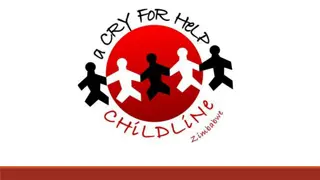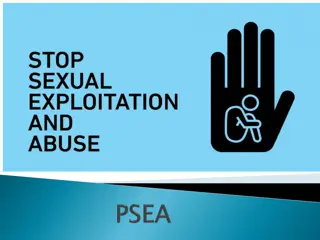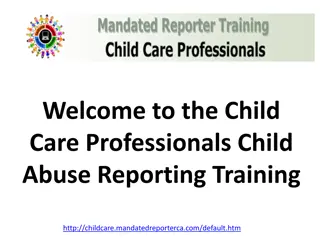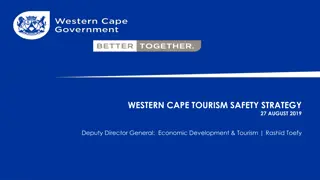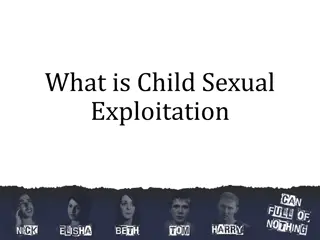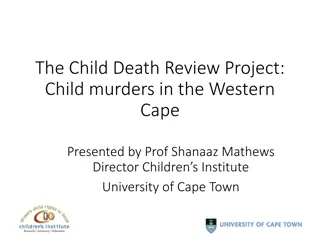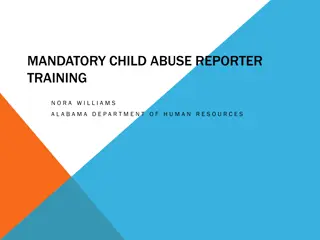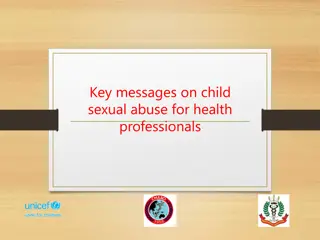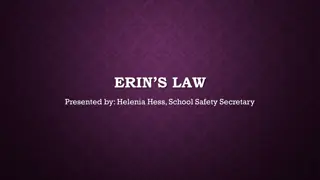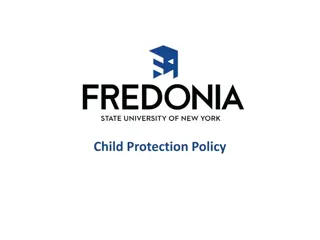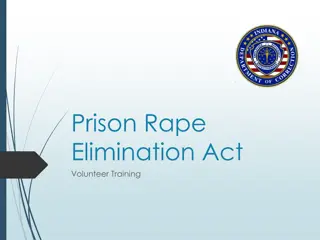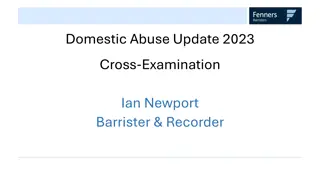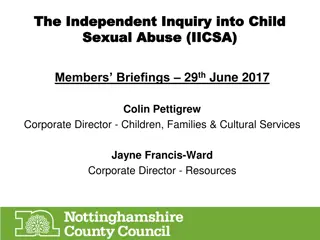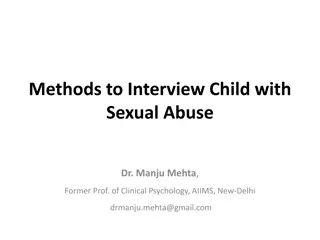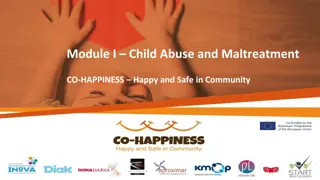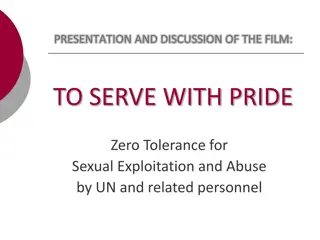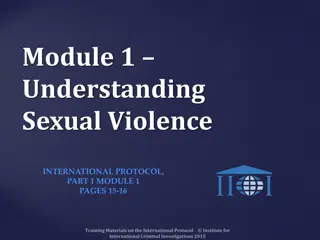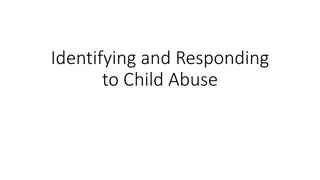Addressing Child Sexual Abuse Investigations in Eastern Cape
Child sexual abuse is a critical issue in South Africa, with delays in investigations hindering justice. This study aims to develop innovative strategies to improve coordination and efficiency in investigating cases in the Eastern Cape region, focusing on overcoming communication gaps, resource constraints, and other challenges.
Download Presentation

Please find below an Image/Link to download the presentation.
The content on the website is provided AS IS for your information and personal use only. It may not be sold, licensed, or shared on other websites without obtaining consent from the author.If you encounter any issues during the download, it is possible that the publisher has removed the file from their server.
You are allowed to download the files provided on this website for personal or commercial use, subject to the condition that they are used lawfully. All files are the property of their respective owners.
The content on the website is provided AS IS for your information and personal use only. It may not be sold, licensed, or shared on other websites without obtaining consent from the author.
E N D
Presentation Transcript
DEVELOPMENT OF AN INNOVATIVE STRATEGY TO ADDRESS DEVELOPMENT OF AN INNOVATIVE STRATEGY TO ADDRESS CHILD SEXUAL ABUSE INVESTIGATIONS IN THE EASTERN CHILD SEXUAL ABUSE INVESTIGATIONS IN THE EASTERN CAPE, SOUTH AFRICA CAPE, SOUTH AFRICA PhD Candidate: Sivuyile Nqaphi Supervisor: Prof Ulene Schiller Co-supervisor: Dr Marinei Herselman
PRESENTATION OUTLINE Introduction Background of the study Problem statement Research questions Aims and objectives Conceptual framework Research method Presentation of findings Discussion of findings Conclusion Recommendations
INTRODUCTION Child sexual abuse is a widespread and growing problem in South Africa, posing a major threat to children's well-being (Hein & Hirsch, 2018). Effective child sexual abuse investigation is critical to proving crimes, apprehending suspects, solving cases, and ensuring justice (Non, 2014). However, poor communication between role players, a lack of awareness about designated social workers, and a lack of acknowledgment of the social work profession all impede the investigative process (Themeli & Panagiotaki, 2014; Brand, 2019). When requesting assistance from the Department of Social Development (DSD), the South African Police Service (SAPS) frequently encounters difficulties, resulting in delays and inadequate support (Sambu, Jamieson, & Mathews, 2017).
BACKGROUND OF THE STUDY South Africa has the most significant number of recorded cases of CSA among African countries. The length of time it takes to investigate these incidents is most troubling in these circumstances. This study is undertaken to determine the root cause of delays during the investigation process with the intention to develop strategies to address these delays during child sexual abuse investigations in the Eastern Cape, South Africa. To improve investigation strategy that optimises resource coordination and minimises isolation among role players must be developed and implemented (Ganeshu, Fernando, Keraminiyage, 2023). the efficiency of child sexual abuse investigations, a collaborative Collaboration among public and private players is required for successful and effective service delivery (Sivangurunathan, Orchard, MacDermid, & Evans, 2019).
PROBLEM STATEMENT Child Sexual Abuse (CSA) is a significant issue in South Africa, affecting victims and society. Despite efforts from various actors, such as the South African Police Service, Department of Health nurses, Department psychologists, the investigation process for CSA cases is often plagued by lengthy delays. of Social Development, NGOs, and These delays prolong suffering and jeopardize the quality and outcomes of investigations, undermining the administration of justice. Factors such as communication gaps, resource constraints, and logistical issues contribute to these delays. DNA evidence processing delays at the National Forensic Science Laboratory further complicate the investigation process. NGOs and the Department of Social Development play a significant role in providing child protection services, but their efforts are insufficient to holistically address the issue.
RESEARCH QUESTIONS 1. What causes the delay in the child sexual abuse investigation process conducted by the SAPS in the selected districts in Eastern Cape province? 2. What are the different role-players' contestations regarding the CSA investigation process? 3. What are the roles and functions of these role-players in addressing child sexual abuse investigations? 4. What are the communication strategies used by the different role-players during the child sexual abuse investigation process?
AIM AND OBCTIVES OF THE STUDY The study aims to develop an innovative strategy to address child sexual abuse (CSA) investigations in the province of the Eastern Cape, South Africa. 1. To determine what causes the delay in the investigation processes of the South African Police Services into alleged CSA cases in selected districts in the province of the Eastern Cape. 2. To identify the contestations by the different role players in the investigation processes of CSA. 3. To determine the roles and functions of different role-players during child sexual abuse investigation processes. 4. To determine the communication strategies used by role-players during the investigation processes of CSA.
THEORETICAL FRAMEWORK OF THE STUDY Ecosystem theory provide a framework for this research study, focusing on child sexual abuse investigations. The Systems theory is a holistic theory based on the fundamental premise that the whole is greater than the sum of its parts (Anfara & Mertz, 2006). This theory considers an individual because it is both an organism and a member of society that immediately recognises the interaction between the individual and their situation or environment (Coulshed & Orme, 2006). When applying systems theory to the child sexual abuse investigation process, the interaction between role players and their processes, as well as how these interactions affect the victims of child sexual abuse, influences whether individual professionals develop positively or negatively (Benson & Pittman, 2001). The effort to change the investigation process will consequently not only be directed at victims of child sexual abuse themselves. However, it would also be better directed at the system in which victims of child sexual abuse are caught up. The study aims to develop a strategy that can improve the efficiency of role players in these cases. Factors causing delays in investigations include the isolation of role players. The structured joint CSA investigation strategy is considered to ease these processes.
RESEARCH METHOD Research Approach The research study takes a qualitative technique to acquire a comprehensive understanding of the responses of role players involved in child sexual investigations. abuse To obtain relevant information and perspectives on the topic, it conducts a comprehensive review of the global literature. Research Design The research study has a descriptive and exploratory design. It s goal is to characterise and analyse the responses of role players investigations, as well as the elements that influence their collaboration and efficiency. participating in child sexual abuse The exploration and description of the case takes place through detailed, in-depth data collection methods involving multiple information sources rich in context. These may include interviews, documents, observations or archival records (Fouch & Schurink, 2011).
RESEARCH METHOD CONTINUE Research Design As the study aims to provide an innovative strategy to address child sexual abuse investigations, intervention research is most suited to this study. Problem analysis and project planning: During this phase, the researcher focuses on the following aspects: Identifying and involving role players, Gaining entry and cooperation from settings permission from the authoritative management to conduct interviews in the study Identifying concerns during the investigation (among role players), Analysing concerns or problems identified. Information gathering and synthesis: Using existing information sources. Studying natural examples, Identifying functional elements of successful strategies. Design: Designing an observational system, Specifying procedural elements of the intervention.
RESEARCH METHOD CONTINUE Research Design Early development and pilot testing: Developing a example or preliminary intervention develop an innovative strategy to address the investigation of child sexual abuse cases. Conducting a pilot test (group presentation session). Applying design criteria to the concept of preliminary intervention. Evaluation and advanced development: Selecting an experimental design one group pre-test-post-test design. Collecting and analysing data. Replicating the intervention under field conditions. Refining the intervention.
RESEARCH METHODS CONTINUE Population This extensive population allows for a thorough comprehension of child sexual abuse investigations. In the province of the Eastern Cape, twenty-one (21) SAPS districts were termed "clusters". The following participants were identified as the population of the study: Investigating Officers, Unit Commanders and Forensic Social Workers from SAPS: Family Violence, Child Protection and Sexual Offences unit. Doctors and forensic nurses from the Department of Health Social Workers from the Department of Social Development, as well as NGOs and Social Workers, private practice Social Workers Psychologist and Prosecutors from the National Prosecuting Authority. This study's population is precisely selected to guarantee a broad representation of sources that provide a complex perspective on child sexual abuse investigations. By incorporating academic literature, professional opinions, and non-research initiatives into the population, the research seeks understanding of the topic. to capture a thorough and in-depth
RESEARCH METHODS CONTINUE Sample This study used non-probability and purposive sampling procedures, with the purposive sample used to sample participants for the qualitative component of the study. Furthermore, professionals in the additional insights and to recommend any missing studies. The sampling strategy is designed to acquire a varied range of sources and perspectives in terms of the duration spent in investigation to help inform the research findings. The processes mentioned above sampling, which involves approaching a specific participant in the phenomenon under investigation. A total of 68 participants were identified and interviewed, whereas 17 members participated in focus group discussions field are consulted privately for were succeeded with snowball
RESEARCHMETHODS CONTINUE Data Analysis Thematic analysis was used to analyse data patterns in child sexual abuse cases. The six-phase approach guides familiarizing oneself with data, identifying themes, reviewing, defining, and reporting findings. Focus group session was employed to gather diverse views and extract broader consensus on the subject. the analysis, focusing on
PRESENTATION OF THE FINDINGS The semi-structured interviews were guided by a planned interview schedule (Annexure C). After completing the interviews, the researcher identified five (05) themes and nineteen (19) sub- themes in connection with views from different role players dealing with child sexual abuse cases and data analysis was conducted. Themes and sub-themes are presented according to the objectives of the study commencing with the first objective. Objective 1: To determine what causes the delays in the child sexual abuse investigation processes conducted by the SAPS in the selected districts of the Eastern Cape Province.
PRESENTATION OF THE FINDINGS Theme Time spent on CSA Sub-theme 1.1 SAPS investigating officers investigation 1.2 Department of Health nurses 1.3 Social workers & private practitioners 1.4 SAPS forensic social workers 1.5 Psychologist 1.6 NPA and court cases 1.7 Forensic science laboratories
PRESENTATION OF THE FINDINGS Sub-theme 1.1: Average time spent by Department of Health: Nurses and Doctors. Reporting and examination delays can impact HIV testing and medical treatment, making it difficult to obtain forensic evidence. Victims should be checked within 72 hours of the incident. Forensic nurses should provide 24 hour services and emergency intervention to sexually abused victims or survivors. The maximum examination period is two to three hours, and medical assessment and examination must occur immediately after the incident. However, nurses and doctors often spend less time gathering evidence, especially when child victim cases are seen within 72 hours.
PRESENTATION OF THE FINDINGS The average time spent by various social workers and psychologists in investigating child sexual abuse cases varies depending on the service, environment, and specific nature of the issue. The Department of Social Development, NGOs, social workers, and private practice social workers all have different time frames for their investigations. Forensic social workers, such as SAPS forensic social workers, use a thorough evaluation model and direct interviews to support the disclosure of child sexual abuse cases. They also conduct forensic evaluations and create reports, which can take anywhere from two weeks to two months. Psychologists, on the other hand, spend an average of six to twenty sessions for child sexual abuse cases. Overall, the investigation of child sexual abuse cases varies depending on the merits of each case and the type of case being investigated.
DISCUSSION OF FINDINGS The average time spent investigating child sexual abuse cases varies among role players, with slight differences due to the nature of operation and challenges faced. Investigating officers have a minimum of three weeks, while nurses and doctors have an average of 45 minutes. Social workers and forensic social workers have a maximum of six sessions and two weeks to two months to complete forensic assessments. The success of a case depends on early inquiry and a specific framework, with a timeframe of seven days for children's assessment. Prosecutors may not be constrained by deadlines, causing inconsistent results. Courts should aim for uniformity in case flow practices and ensure uniformity in the order of events in each case.
Recommendations of the study The study focused on the development of an innovative strategy to address the investigation of child sexual abuse cases; therefore it is recommended that the proposed strategy be implemented. The Joint Child Sexual Abuse Investigation strategy be utilised in the Eastern Cape and other provinces in South Africa, depending on available resources, slight changes or additions may be made to the strategy. Monitoring and evaluation of the strategy proposed by this study should be considered in order to improve the efficiency of the Joint Child Sexual Abuse Investigation strategy. Suitable resources should be utilised according to the needs, roles, and functions of role players. The development of one standard operating procedure for the role players investigating child sexual abuse cases. The Joint Child Sexual Abuse Investigation strategy to be legislated. A pilot study could be conducted to promote the proposed model.
THANK YOU SIVUYILE NQAPHI PhD Candidate University of Fort Hare East London Campus nqaphis@gmail.com 0832404867


